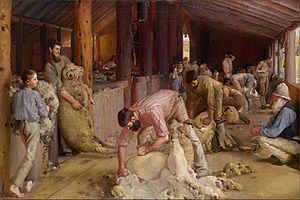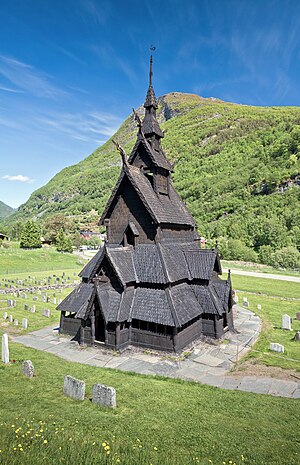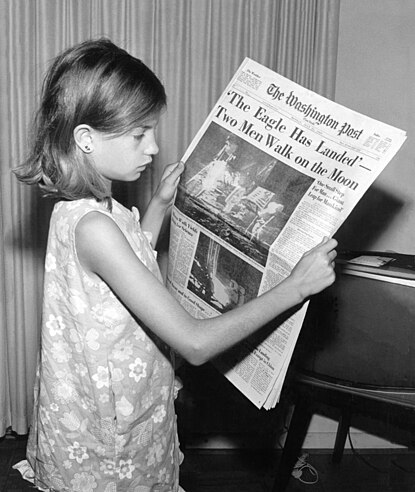Wikipedia:Wikipedia Signpost/2015-08-19/Featured content
Appearance
Featured content
Dead parrots, live frogs, a symbolic kiss and what do we get? Enrique Iglesias!
- We are in heaven
-
Celebrating the 46th anniversary of the Apollo 11 moon landing...
-
Annunciation, by Hans Memling.
-
Ursa Minor, feature article, also a featured picture
This Signpost "Featured content" report covers material promoted from 2 to 8 August.
Featured articles

Five featured articles were promoted this week.
- Annunciation (Memling) (nominated by Victoriaearle and Ceoil) Victoria's and Ceoil's new featured art piece. Painted in 1489 by the Early Netherlandish painter Hans Memling, this artwork depicts the Virgin Mary in a domestic bedchamber receiving the richly dressed Archangel Gabriel and two attendant angels. It is the Annunciation, the moment in time when the Virgin receives the news that she will bear the Son of God. The 15th-century viewers would have understood the hidden language of the objects and the lighting: the white lilies in the painting symbolize the purity of the Virgin, as does the light shining on the sideboard and passing through the glass of the water flask, the candle-holder, the dove above her head in a halo is the symbol of the Holy Spirit, while the irises are symbols of suffering. The light was associated with Mary and the incarnation, and it has a special significance in the painting, symbolizing the divine light.
- Chetro Ketl (nominated by Rationalobserver) Chetro Ketl is a structure of a type known as a great house, which was built by the Ancestral Puebloans staring in 990 CE and nearing completion circa 1075 CE. It's situated in Chaco Culture National Historical Park in northwest New Mexico, USA.
- History of Liverpool F.C. (1892–1959) (nominated by NapHit) Liverpool Football Club were founded when local brewer John Houlding found himself the owner of a football ground without a football team. The ground at Anfield had been rented to Everton Football Club; Houlding put pressure on the club to buy the ground, which would have given him a substantial profit. They decamped, and Houghton decided to form a new club, also called Everton. The Football League forced him to adopt another name, thus depriving generations of footy fans of the chance of seeing Everton playing with themselves. He chose "Liverpool", and dispatched his manager John McKenna on a recruiting trip in Scotland. The entirely Scottish team played their first match on 1 September 1892 , a friendly against Rotherham Town which Liverpool won 7–1. By the 1950s the club had gone into a slow decline. In 1959 (the endpoint of this article) Bill Shankly was appointed manager. He stayed in the job until his retirement in 1974.
- Mascarene grey parakeet (nominated by FunkMonk) The Mascarene grey parakeet was endemic to Mauritius and Réunion, but has been extinct since the 1760s. The parakeets were hunted for food although they were regarded as lean and tough meat. When caught a bird would cry out- the cry attracted hundreds of parakeets who would wheel around the trapped individual. Hunters would then bat the parakeets out of the sky with sticks. Being a forest dweller, the deforestation of the islands by slash-and-burn contributed to their decline.
- Ursa Minor (nominated by Casliber) Ursa Minor or the Little Bear is a star constellation in the northern sky. The brightest star in the constellation is Polaris, otherwise known as the North Star, whose apparent position is close to the north celestial pole. Mariners have used this star for navigation since time immemorial. There is also a constellation called Ursa Major, also known as the Great Bear .
Featured lists
- Here singing:
-
and Placido Domingo


Eight featured lists were promoted this week.
- Azealia Banks discography (nominated by Azealia911) Azealia Banks is an American rapper who has released one album, Broke with Expensive Taste and a number of singles and music videos. Banks describes herself as the "cunt queen", which she attributes to her upbringing- "I'm from Harlem. I went to art school; I grew up with the cunts...To be cunty is to be feminine."
- Billboard Latin Music Award for Reggaeton Album of the Year (nominated by DivaKnockouts) Reggaeton is a musical genre developed from Spanish-language reggae. The music has characteristic rhythms derived from the Jamaican hit Dem Bow by Shabba Ranks, produced by Bobby Digital, who promoted the use of digital drum machines. Reggaeton artists tend to rap their lyrics in a hip-hop style.
- Grammy Award for Best Latin Pop Album (nominated by Jaespinoza) The National Academy of Recording Arts and Sciences has presented this award since 1984 with various name changes. The latest awardee is Panamanian artist Rubén Blades, who also won in 2000 – the only person to have won twice.
- List of Derbyshire County Cricket Club grounds (nominated by ChrisTheDude and AssociateAffiliate) Derbyshire County Cricket Club was established in 1870 and has played first-class cricket at the County Ground in Derby since August 1871. It has remained the main ground, but the club has played first-class, List A and Twenty20 matches at twenty other grounds including Park Road, Buxton, where a game in June 1975 was halted due to snow.
- List of amphibians of Bulgaria (nominated by Gligan) Bulgaria is a hospitable home to twenty species of amphibians; newts, frogs and toads. The Macedonian crested newt is the latest species to join the menagerie – it was raised to species rank after molecular phylogenetic research in 2007 revealed that it wasn't a subspecies of some other newt.
- List of awards and nominations received by Satyajit Ray (nominated by Vivvt) Satyajit Ray was a world-renowned film director and composer of film scores who received awards and recognition for his 36 films made over a career spanning from 1950 to 1992. Ray was prominent in Bengali cinema although he also made films in Hindi; his awards were for directing, screenplay writing, composing and writing lyrics. He was awarded an honorary Oscar in 1992 for his "rare mastery of the art of motion pictures, and of his profound humanitarian outlook".
- List of international cricket five-wicket hauls by Graeme Swann (nominated by Sahara4u and Harrias) Graeme Swann is a former English cricketer, employed as a right-arm off spinner. The off spinner typically uses accuracy and variation in pace to dismiss the batsman. Swann has taken five or more wickets in a single innings during eighteen international games making him joint twenty-seventh in the list of haulers.
- List of York City F.C. players (fewer than 25 appearances) (nominated by Mattythewhite) This is a list of those football players who have played for the first team of York City F.C. (including as substitutes) for between one and twenty-four times. Of the more than 500 players, some were on loan from other clubs, and others played for the club for a short period before transferring.
Featured pictures
-
Portrait of the landscape painter Frederik Sødring, by Christen Købke





Sixteen Featured pictures were promoted this week.
- Mound of Butter (created by Antoine Vollon; nominated by Crisco 1492 and Hafspajen) The Realist painter Antoine Vollon was noted for his still lifes, of which this is one, painted so realistically that the art critic Grace Gluek couldn't believe it's not butter. Vollon also painted singeries and figure paintings. An example of the latter, Femme du Pollet à Dieppe (a peasant woman carrying a large basket on her back), won first prize at the 1876 Salon, only to be stigmatised by Édouard Manet as "a basket that walks".
- Abolhassan Banisadr (created by Christoph Braun; nominated by Alborzagros) Iranian politician and economist Abolhassan Banisadr was the first president of the Islamic Republic. He was involved in the student movement against the Shah, and fled to France in 1963. At his father's funeral in Iraq in 1972 he met Ayatollah Khomeini. Banisadr became one of Khomeini's advisors, and returned to Iran to become deputy minister of finance in February 1979. By year's end he had become foreign minister. In January 1980 Banisadr was elected president, receiving 78.9% of the vote. On 10 June 1981 he was appointed acting commander-in-chief of Iranian forces during the Iran–Iraq War by Khomeini. On 21 June he was impeached by the Majlis, a move which appears to have been instigated by Khomeini. Close friends of Banisadr were executed, but Banisadr himself was already in hiding, and was able to escape the country by plane. Granted asylum by the French he lives in a closely-guarded villa in Versailles.
- Nicolas Lanier (created by Anthony van Dyck; nominated by Hafspajen) Nicholas Lanier was the first Master of the King's Musick, a composer, and also a painter and scenographer himself – he served both Charles I and Charles II, with a short break in the Netherlands during the Commonwealth. Of Huguenot origin, his major contribution to artistic culture was in persuading Charles I to bring the artist who painted him, Anthony van Dyck, to England. This portrait of Lanier by van Dyck depicts him in an attitude of sprezzatura or "studied carelessness"; the ability to convince other people that you can do what you do, standing on your head and whistling "Colonel Bogey".
- Limosa harlequin frog (created by Brian Gratwicke; nominated by Bruce1ee) Atelopus limosus The limosa harlequin frog is actually an endangered species of toad, which is endemic to Panama. Fungus infections and habitat loss have caused populations to decline. The toad is found in two colour forms; a lowland type in brown with a yellow nose, and an upland version in green with black chevrons; males of both types have white bellies while females have red bellies.
- Borgund Stave Chuch (created by Ximonic; nominated by Alborzagros) Borgund Stave Church is a stave church from Norway, almost a thousand years old. The church is built entirely from wood, made with tiered, scissor beam, overhanging roofs, while the walls are made with vertical wooden boards called staves. The church is owned by the Society for the Preservation of Ancient Norwegian Monuments (SPANM). A a replica of the church can be seen in Rapid City, South Dakota in the United States.
- Cepot (created and nominated by Crisco 1492) Cepot is a character from an Indonesian puppet theatre or wayang; this puppet is a wayang golek, a wooden doll controlled by rods. His character is that of an easy-going rural jokester.
- Pachygrapsus marmoratus (created and nominated by PetarM) The marbled rock crab is small and fast-moving; it's coloured dark violet-brown with yellow marbling. The crab eats a balanced diet of meat and one veg (algae). The meat comes from mussels and other marbled rock crabs. If there's no mussels, barnacles will do. As the seas warm, the range of the crab has spread outwards- they've been spotted in Southampton, a major centre for cruising.
- The Kiss (created by Edvard Munch; nominated by Crisco 1492 and Hafspajen) The Kiss is an oil painting by Edvard Munch. It depicts a couple embracing and kissing, their faces rendered as a single form resembling a pink map of Africa, with a single ear where Timbuktu should be. The form is regarded as symbolising the unity of their relationship; Munch was a symbolist, attempting to "represent absolute truths that could only be described indirectly". The painting has a certain sinister atmosphere, thanks to the dark coloring and the anonymity of the couple, somewhat reminiscent of Munch's famous painting The Scream.
- Scene of Don Carlo (created by Giuseppe Barberis and Carlo Cornaglia; restored and nominated by Adam Cuerden) A wood engraving by Carlo Cornaglia of a performance of Verdi's opera Don Carlos, the digital image expertly restored by the nominator with Adam's usual careful attention to authenticity. Note Cornaglia's signature lower right; the letters are formed by cutting away the outlines, leaving a raised area which prints black. Also he's done the "n" backwards. The opera? Five acts, four hours, tunes that can only be successfully whistled by a Guanche, long queue for the facilities.
- Last scene of Attila (created by an unknown author; restored and nominated by Adam Cuerden) This wood engraving published in the world's first illustrated newspaper, The Illustrated London News shows the final scene from Verdi's opera Attila as performed in London in 1848. Once upon a time there was an evil king, Attila, King of the Huns and Zacharias Werner wrote a play on him. Verdi liked the ultra-Romantic play, so he made an opera of it. Summa summarum, it is always right to sing Veni Creator Spiritus in a precarious situation. The engraving has been restored by the nominator, who removed the red library inventory stamps and the text showing through from the other side of the paper.
- Golden coin from the Duchy of Parma (created by the Duchy of Parma; nominated by Godot13) The golden doubloons from the Duchy of Parma depict Odoardo Farnese, Duke of Parma very well, (you don't want to know how Odoardo really looked like, so don't click on that link) who came to power after Ranuccio's natural son, his brother and rival, Ottavio, was relegated to a prison. He was the legitimate son of the attractive Ranuccio I Farnese who had to many lovers and sons.
- Girl reading the July 21, 1969, edition of The Washington Post (created by Jack Weir; nominated by Pine) Recently shown in a Signpost Gallery celebrating the 46th anniversary of the Apollo 11 moon landing, this photo uploaded by a Wikimedian of his mother was taken by his grandfather.
- Set design model for Act I of Otello (created by Marcel Jambon; nominated by Adam Cuerden) The featured picture is a scene in Otello, a dramatic and wonderful four act opera, by Italian composer Giuseppe Verdi, widely considered as one of his best, played all over the world. The libretto was written by Arrigo Boito, while the stage setting was designed by Marcel Jambon (1848-1908). The story is based on Shakespeare's tragedy, Othello. The story of Othello is the story of a man who loved, but not wisely, and who listened to ill-willing advisors instead of using his own head and thinking a bit himself. Iago is the evil friend who is twisting and monitoring the plot, telling everybody he does not want to cause trouble, but this is exactly what he wants. Iago is considered the archetypal character of the villain and the quintessence of evil, who manipulates all the other characters at will, getting close to them, orchestrating his evil schemes, entangling them in a confusing net of lies, playing on their weaknesses and goodwill, all this without his victims, Othello and Desdemona, ever noticing it. This goes on until Othello, who loved and trusted Desdemona before, now is turning against her, judging her rashly and brutally, while Desdemona desperately denies. Othello in an overconfident act is strangling his own wife, only to find out later that his jealousy was pointless – she and Cassio were innocent. Othello takes his own life in remorse. The opera follows the Shakespearean plot and there is no happy ending to the work.
- Portrait of Frederik Sødring (created by Christen Købke; nominated by Crisco 1492) This featured picture depicts the Danish landscape artist Frederik Sødring. The portrait was painted in 1832 by Christen Købke, an artist who was active during the Golden Age of Danish Painting, an art movement inspired by the Romantics from the neighboring country, Germany.
- Shearing the Rams (created by Tom Roberts; nominated by Hafspajen) Shearing the Rams from 1890 by the Australian artist Tom Roberts (1856–1931) is one of the continent's "most well known and loved paintings". Roberts painted it in a shearing shed at Brocklesby sheep station in New South Wales, making sketches during the spring of 1888 and returning a year later to start the canvas. It is believed Roberts did most of the painting at the shed; in 2006 a piece of wood from the now-demolished building was found to have paint daubs precisely matching the palette of the picture. The smiling "tar boy" at the centre was a young girl, Susan Davis, who died in 1979, probably much over ninety years old. Sometimes it is healthy to be in a famous painting. Roberts was an influential member of the Australian art movement called the Heidelberg School, whose members painted many of Australia's early colonists, pioneer settlers, rural labour, shearers, swagmen, bogans, standover men and mountain horsemen, all fighting with the hardships of the rough environment. The sheep shearers in the painting are described as "the most characteristic and picturesque of the shearers and roustabouts".
- Zeche Zollverein (created by Der Wolf im Wald; nominated by Alborzagros) Zollverein Coal Mine Industrial Complex is a UNESCO World Heritage Site in Essen, North Rhine-Westphalia, Germany. Part of the European Route of Industrial Heritage, it is built in Bauhaus style. The site composed by Zollverein Coal Mine and Zollverein Coking Plant, is considered as the “most beautiful coal mine in the world”. Hey! Did you happen to see, the most beautiful coal mine in the world? And if you did was it mining?
-
Model for set design of Giuseppe Verdi's Otello in Paris















Discuss this story
The Otello set design image is fantastic; it's the first such image I've ever seen on Wikipedia, let alone as an FP. BobAmnertiopsis∴ChatMe! 17:29, 20 August 2015 (UTC)[reply]